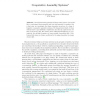Free Online Productivity Tools
i2Speak
i2Symbol
i2OCR
iTex2Img
iWeb2Print
iWeb2Shot
i2Type
iPdf2Split
iPdf2Merge
i2Bopomofo
i2Arabic
i2Style
i2Image
i2PDF
iLatex2Rtf
Sci2ools
234
Voted
DNA
2011
Springer
2011
Springer
Cooperative Assembly Systems
Several molecular systems form large-scale objects. One would like to understand their assembly and how this assembly is regulated. As a first step, we investigate the phase transition structure of a class of bipartite cooperative assembly systems. We characterize which of these systems have a (probabilistic) equilibrium and find an explicit form for their local energy (§2). We obtain, under additional limitations on cooperativity, the average dynamics of some partial observables (§4). Combining both steps, we obtain conditions for the phase transition to a large cluster (§5). Numerous intracelullar molecular systems (post-synaptic densities, bacterial chemotaxis sensors, or focal adhesion complexes) form extensive structures which are somewhat intermediate between traditional signalling complexes and largescale objects more familiar from statistical physics. One would like to understand the specific regulation controlling their assembly and how this regulation relates to theirs ...
Related Content
| Added | 18 Dec 2011 |
| Updated | 18 Dec 2011 |
| Type | Journal |
| Year | 2011 |
| Where | DNA |
| Authors | Vincent Danos, Heinz Koeppl, John Wilson-Kanamori |
Comments (0)

